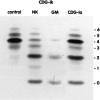Congenital disorder of glycosylation type Ik (CDG-Ik): a defect of mannosyltransferase I
- PMID: 14973782
- PMCID: PMC1182267
- DOI: 10.1086/382493
Congenital disorder of glycosylation type Ik (CDG-Ik): a defect of mannosyltransferase I
Abstract
This study describes the discovery of a new inherited disorder of glycosylation named "CDG-Ik." CDG-Ik (congenital disorder of glycoslyation type Ik) is based on a defect of human mannosyltransferase I (MT-I [MIM 605907]), an enzyme necessary for the elongation of dolichol-linked chitobiose during N-glycan biosynthesis. Mutations in semiconserved regions in the corresponding gene, HMT-1 (yeast homologue, Alg1), in two patients caused drastically reduced enzyme activity, leading to a severe disease with death in early infancy. One patient had a homozygous point mutation (c.773C-->T, S258L), whereas the other patient was compound heterozygous for the mutations c.773C-->T and c.1025A-->C (E342P). Glycosylation and growth of Alg1-deficient PRY56 yeast cells, showing a temperature-sensitive phenotype, could be restored by the human wild-type allele, whereas only slight restoration was observed after transformation with the patients' alleles.
Figures





References
Electronic-Database Information
-
- GenBank, http://www.ncbi.nih.gov/GenBank/ (for HMAT-1 [accession number AB019038], genomic-level HMT-1 [accession number NT_010552], and the coding region of HMT-1 [accession numbers AB019038 and NM_019109])
-
- Online Mendelian Inheritance of Man (OMIM), http://www.ncbi.nlm.nih.gov/Omim/ (for MT-I and ALG1)
-
- Saccharomyces Genome Database, http://www.yeastgenome.org/ (for yeast genetics)
References
-
- Couto JR, Huffaker TC, Robbins PW (1984) Cloning and expression in Escherichia coli of a yeast mannosyltransferase from the asparagine-linked glycosylation pathway. J Biol Chem 259:378–82 - PubMed
-
- Gietz RD, Woods RA (2002) Transformation of yeast by lithium acetate/single-stranded carrier DNA/polyethylene glycol method. Methods Enzymol 350:87–96 - PubMed
-
- Huffaker TC, Robbins PW (1982) Temperature-sensitive yeast mutants deficient in asparagine-linked glycosylation. J Biol Chem 257:3203–3210 - PubMed
MeSH terms
Substances
LinkOut - more resources
Full Text Sources
Medical
Molecular Biology Databases

